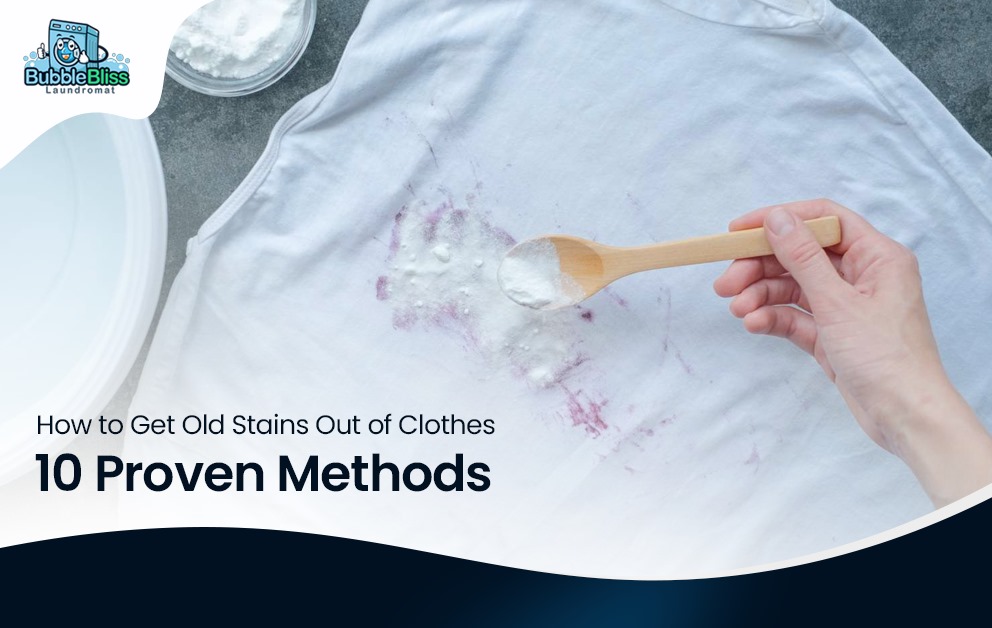You swear you put that shirt away clean, yet now it looks like a painting you did not commission. Time travel to hit the spill instantly is not an option. Thus, we deal with the epic consequence: the dreaded stubborn stains. It feels like these marks are mocking you every time you pull the garment out.
Do not rage quit on your wardrobe just yet. There is a whole world of next-level laundry tips and powerful stain removal knowledge waiting. This is the simple, straightforward guide you need to figure out precisely how to get old stains out of clothes and permanently remove old stains. Let us save your favorite items.
Why Old Stains Are Hard to Remove
A fresh spill is easy to lift because the stain molecules sit primarily on the fabric’s surface. Give it a few days, conversely, stain absorption begins. The liquid or oil seeps deep into the microscopic crevices of the fabric fibers. The stain then dries out. This process creates chemical bonds between the residue and the textile material, resulting in set-in stains.
This setting action is why standard detergent alone is not enough. You need specific chemical agents and agitation to break those bonds. Understanding this science is the first step in learning exactly how to get old stains out of clothes efficiently.
Tip 1: Pre-Treat With Baking Soda
When stains linger, baking soda laundry treatments come to the rescue. Sprinkle a layer over damp fabric or make a paste with water. This natural stain remover gently breaks down dirt while handling odor removal without harsh chemicals. Leave it on for 15–30 minutes before washing as usual for a clean and refreshed result.
| Method | Application Time | Ideal For |
| Baking Soda Paste | 20–30 minutes | Sweat, coffee, or mild food stains |
| Dry Sprinkle | Overnight | Deep odor or discoloration patches |
Tip 2: Use White Vinegar for Stubborn Stains
A vinegar laundry trick never fails to surprise. White vinegar acts as an odor neutralizer and performs gentle stain treatment on tough spots. Pour a bit directly onto the stain or mix one part vinegar with two parts water for a soak. The mild acid dissolves residue while freshening up the fabric’s texture.
| Mix Ratio | Duration | Best Used On |
| 1:2 (Vinegar:Water) | 30 minutes | Sweat stains, deodorant marks |
| Pure Vinegar Dab | 10 minutes | Ink or dye smudges |
Tip 3: Hydrogen Peroxide for Whites
Hydrogen peroxide is a go-to choice for lightening peroxide laundry stains on white and colorfast fabrics. This is a mild oxidizing agent, acting like a gentler bleach alternative. It works by changing the chemical structure of the color-causing molecules, making them invisible.
To perform a stain removal treatment, combine one part peroxide with one part dish soap. Apply the mixture directly to the mark. Let it fizz for a few minutes; rinse it with cold water. Caution is necessary: always test hydrogen peroxide on an inconspicuous area of colored clothing first. This ensures you master how to get old stains out of clothes without bleaching the entire garment.
Tip 4: Lemon Juice and Sunlight
Fresh lemon stain removal methods are the eco-friendliest fix. Lemon acts as a natural bleach, and paired with sunlight, it becomes a powerful sun treatment. Apply lemon juice on the mark and leave the cloth under the sun for an hour. The natural acids help fade old discoloration while refreshing the garment’s brightness.
| Step | Description |
| 1 | Squeeze fresh lemon juice directly on the stained area |
| 2 | Lay fabric flat in sunlight for 1–2 hours |
| 3 | Rinse thoroughly and air dry |
Tip 5: Dish Soap for Grease or Oil Stains
Oil and water do not mix. That is the fundamental problem with grease removal. The solution is an emulsifier: dish soap. Soap contains surfactants that break oil into tiny droplets, allowing them to mix with water and be rinsed away.
For oil stain tips, apply a small dab of grease-fighting dish soap laundry product directly to the stain. Gently rub it in using your finger or a soft brush. Let it sit for up to an hour. Rinse thoroughly before washing. This pre-treatment step is essential for knowing how to get old stains out of clothes that have been splattered with cooking oil or butter.
Tip 6: Commercial Stain Removers
Sometimes, homemade remedies just cannot handle the assignment. That is when you level up to commercial laundry solutions. Look for products that utilize an enzyme cleaner. Enzymes are large protein molecules that act as tiny biological scissors, snipping apart the complex molecules of a stain.
Choosing the right type of enzyme is key for targeted stain cleaning:
| Enzyme Type | Target Stain Category | Example Stains |
| Protease | Protein-based | Blood, eggs, grass, dairy, sweat |
| Lipase | Fat/Oil-based | Grease, lipstick, cooking oil |
| Amylase | Starch-based | Chocolate, sauces, starches |
| Cellulase | General soil/Pills | General discoloration, pilling |
For super tough spills, choose a commercial product containing a mix of these enzymes.
Tip 7: Soaking Clothes Overnight
Good stain soaking works like a miracle for long-standing marks. Combine detergent with warm water for an easy pre-wash treatment. Leave garments submerged overnight. This stubborn stain hack lets cleaning agents loosen residue deep within fibers so the next wash finishes the job.
| Soak Time | Additives | Results |
| 6–8 hours | Enzyme detergent | Loosens old dye or protein stains |
Tip 8: Proper Washing Techniques
The type of stain determines the ideal washing machine settings. For almost all old stains, a long wash time helps. However, temperature is a game-changer. Never expose protein stains (blood, dairy, grass) to warm or hot water right away. Heat permanently cooks and sets protein into the fabric.
Review these hot/cold water rules for effective laundry cycle tips:
| Stain Category | Pre-Rinse / Initial Soak | Final Wash Temperature |
| Protein-Based | Cold Water Only | Warmest temperature safe for fabric after stain is gone |
| Oil/Grease-Based | Apply soap, rinse warm | Hottest temperature safe for fabric (heat helps melt oil) |
| Tannin-Based | Cold Water Rinse | Warmest temperature safe for fabric |
Always select the cycle best suited for the fabric to prevent damage.
Tip 9: Drying Tips to Avoid Setting Stains
You have put in the work, applying multiple stain treatment methods. Do not ruin it all in the final step. Heat is the natural enemy of any remaining discoloration. Tossing a still-stained garment into the machine dryer guarantees the stain will set for good.
The key is air drying. Once you believe the stain is gone, hang the garment up or lay it flat to dry. This simple precaution lets you visually inspect the area when the fabric is completely dry. If you see a shadow of the stain remaining, repeat the pre-treatment and washing steps. Use the dryer tips only when you are 100% stain-free. This is the only way to prevent stains setting.
Tip 10: Professional Laundry Services for Stubborn Stains
For heirloom fabrics, vintage clothes, or truly impossible marks, turn to laundry professionals. These experts have access to industrial solvents and high-grade chemicals not available to the general public. They understand complex material science. This is especially true for items requiring dry cleaning stains expertise.
Consulting with laundry professionals can save you money in the long run. They know precisely which chemical combination will work on your garment without compromising the fabric’s dye or texture. They offer guaranteed tough stain solutions that eliminate the guesswork involved in learning exactly how to get old stains out of clothes yourself.
FAQs About Removing Old Stains
These are the common spot removal questions people have when dealing with permanent marks:
- What are the best home remedies for persistent stains?
Ans: The most reliable home remedies involve using a specific agent based on the stain type: dish soap for grease, vinegar for coffee, and hydrogen peroxide for blood or dye on white fabric.
- Are there any laundry hacks for set-in stains?
Ans: Yes, the key is the pre-soak. Combining an enzyme detergent with a long stain soaking period (up to 12 hours) is the strongest laundry hacks for making deep-rooted stains movable.
- How can I tell if a stain cleaning method is safe for my fabric?
Ans: Always perform a spot test. Apply the solution (homemade or commercial) to a hidden seam or hem of the garment. Wait 10 minutes. If there is no discoloration or fiber damage, it is safe to proceed.
End Note
Fresh clothes tell better stories. Using these 10 strategies, anyone can remove stains fast without damaging texture. A bit of patience and smart laundry tips ensure long-lasting fabric care. For garments that need expert hands, Bubble Bliss Laundromat is always ready to bring them back to life—clean, bright, and looking new again.


